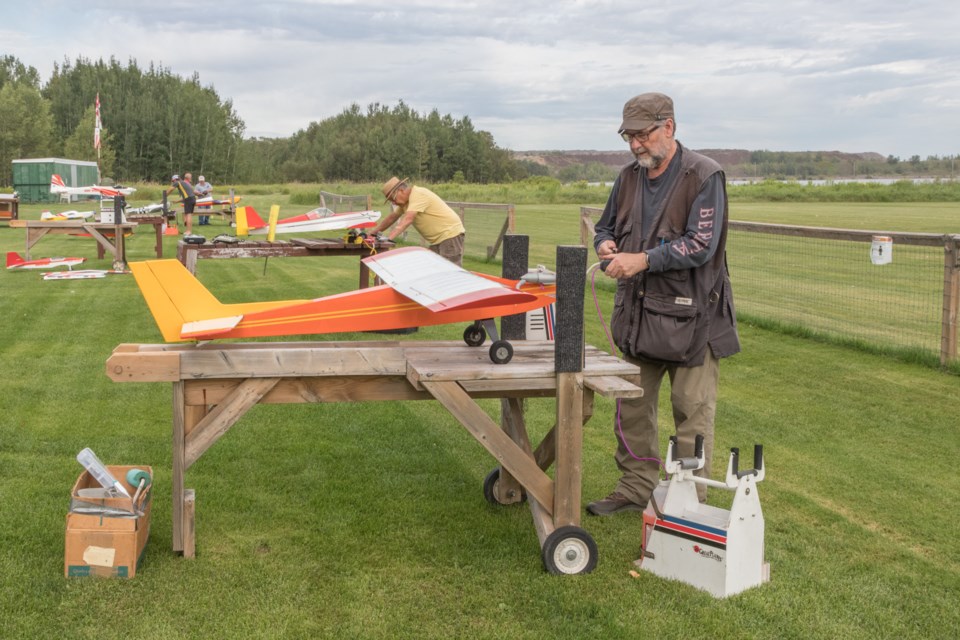When you visit the airfield in the west end of Sault Ste. Marie that houses Soo Modellers Flying Club it's like an awakening to the senses.
The colour, sound, speed, smell, action and ear to ear grins all feed a feeling of collaboration and community.
Peter Smith always knew he wanted to fly.
He grew up with aircrafts in his life.
While in primary school his father served as a navigator in a WW2 bomber.
"I started flying control line planes when I was a teenager. I knew I wanted to fly radio controlled (RC) planes, but I didn’t have the money to start up, so I flew on lines going around in a circle,” Smith said. “I taught myself but got very frustrated. Life got busy, and I finally got the time to fly RC when I moved to the Sault 15 years ago. I joined the Soo Modellers Club, got an instructor, and have been flying ever since."
It seems that between materials for building, flying, repairs and upkeep of these vessels can be very expensive, and once flown they are not insurable in the field.
At times if conditions are favourable to trouble a pilot is generally safe but an aircraft may not be so fortunate.
"The most important beginners first step is to go to a RC flying club field and talk to the experienced flyers," said Smith.
"I have a Fokker Triplane WW 1 Fighter EPP foam kit aircraft that I built that is my favourite indoor flyer."
"I fly many different RC model aircraft,” Smith added. “Indoors, I fly mainly electric powered EPP foam aircraft that are built from kits and some that are ready to fly (RTF). Outdoors, I fly electric and nitro fuel aircraft, mainly almost ready to fly (ARF) and kit model aircraft built out of balsa wood and covered in an adhesive backed plastic film."
Peter has had his “Wings“ to fly at the Soo Modeller’s Club for about 13 years.
You must have an instructor to initially fly at the club. Your radio is connected to an instructor’s radio, through what is known as a buddy box during training.
After you have passed your flight school by an instructor, you get your “Wings" and are allowed to fly at the field when it is open.
There are restrictions on noise produced by nitro and gas engines and the start time is 9 a.m. for those. Electrics make very little noise and have few restrictions.
COVID-19 has created social distancing at the field.
Soo Modellers Club is a registered Model Aviation Association of Canada (MAAC) flying field and follow their regulations which are outlined on the website.
MAAC membership is mandatory for all members and is the source of their flying insurance.
Flying happens throughout the week in summer and begins outdoors as soon as the access road is able to accept vehicle traffic. Thursday evenings are known as club nights. It then moves indoors for the winter months for some who fly electric aircraft.
The sky is the limit when it comes to acquired skills.
There are members that fly in Scale Acrobatic Competitions, others that fly scale aircraft that look and fly like full size airplanes.
Others fly sport aircraft and float planes.
Soo Modellers Club is strategically located on the St Mary's River for off-water flying and includes a long grass strip that was once the Algoma Steel full size aircraft landing strip.
With the COVID-19 pandemic at hand, supplies for the hobby at this time can be hard to come by. They are mainly attained by mail order.
“We don’t have a hobby store in the Sault that sells supplies for modeling. We can’t even get fuel for our nitro engines here. There is a shift from nitro fuel to gasoline happening now,” Smith said. “A gallon of nitro fuel is up to about $50 Canadian. Gasoline and oil to mix in will cost about $5 to $6 Canadian per gallon. Some glues are available here and Michael’s has some supplies, but it is limited. There also is a switch to electric powered motors and foam models. These are quieter, and less polluting during operation, but use rechargeable batteries that are hazardous waste when exhausted."
"Some RC flyers reserve the term ‘build’ to (refer to) people who build from scratch. I don’t have enough time to do that, so I assemble ARF models,” Smith added. “They are partially finished models that need assembling, and complete radio electronic and motor installation and setup. This saves some time, but also can be frustrating with the constraints the model kit manufacturer has made. You have to do some modifications to make the aircraft ‘yours.’”
There are approximately 30 - 40 club members with surprisingly only one being female. More information about model aircraft flying with Soo Modellers Club can be found when you check out the website for Soo Modellers at soomodellers.ca.
